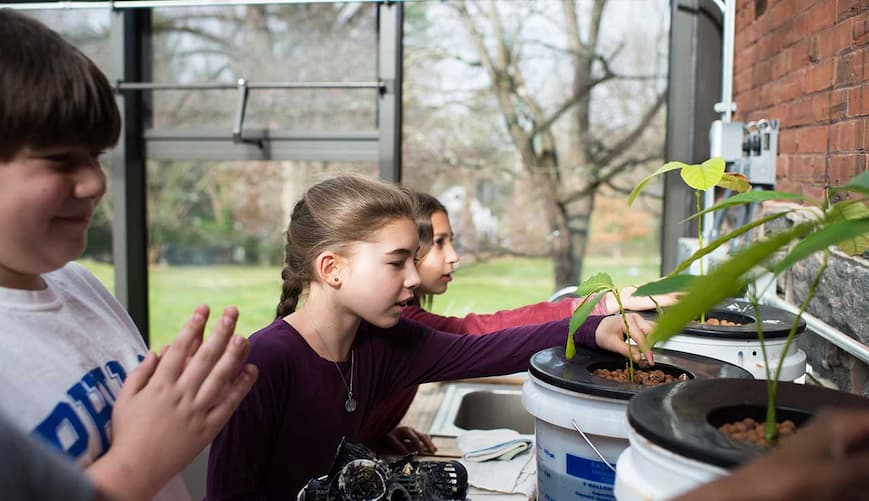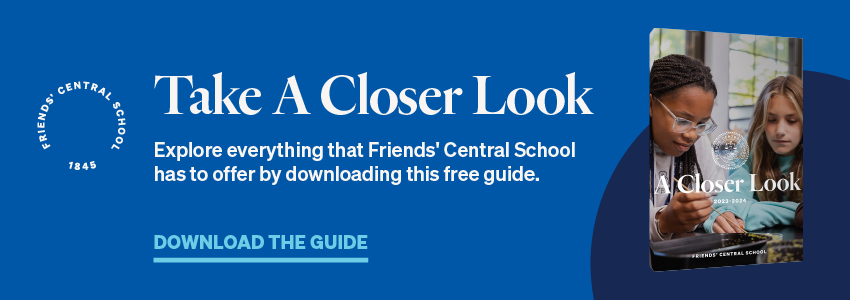
Hands-on learning has long been touted by parents and educators as a key factor in raising children who develop a lifelong love of learning and who perform better academically. But what exactly do we mean when we say “hands-on learning,” and why is it so beneficial to students? Here, we explore both the concept and the benefits.
What is hands-on learning?
Hands-on learning is a form of education in which children learn by doing. Instead of listening to a teacher or instructor lecture about a given subject, the student engages with the subject matter to create something or solve a problem.
Free Downloadable Guide: Take a Closer Look at Friends' Central School
Though certain subjects come to mind more readily than others when talking about hands-on learning (for example, shop class), the truth is, a hands-on educational philosophy can be incorporated into nearly any subject matter. This philosophy provides students with engaging hands-on experiences that will further develop the learning process. A few examples might include:
- Solving problems as a part of math class
- Completing a lab experiment as a part of a science class
- Building circuits or working machines as a part of a tech class
- Recreating a historical document or artifact as a part of history class
- Writing a creative story, poem, or essay as a part of English class
The benefits of hands-on learning
Hands-on is by no means a “new” movement in the classroom. That being said, even today, many schools find it difficult to incorporate hands-on projects and principles into student work. This can be a particular challenge for public schools, which often have tight budgets and less freedom in developing curriculum.
And that’s a real shame, because hands-on learning brings so many benefits to students, including:
- It is a more engaging way to learn
- Leads to increased retention
- Offers practice in problem solving and critical thinking
- Often results in a physical creation
1. Hands-on is another way to learn.
Hands-on learning allows for equal visibility of common learning styles in the classroom. Some children learn best by looking at visuals, some by listening to a parent or teacher speak, and some by reading and writing about a given topic. These are called visual, auditory, and reading/writing learning styles, respectively. But there is a fourth learning style that is easy to overlook: Kinesthetic learning, which is a fancy way of saying “learning by doing.”
There are a lot of theories about why hands-on learning is so effective. The reality is, there is no single reason why. But one hard-to-argue fact about hands-on learning is this: It is incredibly engaging.
When students are forced to do something, they are engaged in active learning. They’re practicing their critical thinking skills and they’re putting their knowledge to the test. Most importantly, this form of learning gives opportunities for students to actively create knowledge, instead of passively consuming it.
In order to create, in order to do, students must be engaged in their education. And engagement has for years been linked to greater academic success like increased test scores and greater academic achievements.
2. Hands-on gives students practice.
Beyond simply leading to better engagement, hands-on learning allows students to practice the skills that they've already learned. As anyone who has ever learned a skill or learned information can attest to, the more practice you get, the better you will be at that skill, and the better you will be able to retain the information.
We can see this in action in many science classes around the country, which pair traditional study (lecture, discussion, reading) with active learning concepts in lab sessions. While students may learn about a concept in the classroom, it is by walking through an experiment in the laboratory that they are able to put that concept into action and gain practice in actually applying it. This process has been shown to lead to higher retention and a better understanding in the subject.
3. Hands-on gives students something “real.”
When it comes to education, one of the most difficult things for young children to understand is how what they are learning is important. They want to know: When will I use this in my life? Why does it matter?
Incorporating hands-on learning into the classroom or into the home is an easy way for parents and teachers to show their children exactly how what they are learning can be used in the real world.
Through hands-on learning, students will often actively create something, whether an essay, story, piece of art, construction project, or something else. This is something real. It is something that a student can look at and think: I was able to create this because of what I've learned and because of the skills that I've practiced.
Project-based learning can make this realization incredibly empowering because it shows students that they can have an impact on the world around them. It shows them that they can use their education to achieve something. And it’s a physical embodiment of what they’ve learned.
4. Hands-on lets students be creative.
Creativity is a muscle. Just like other muscles, it needs to be regularly exercised or else it will become harder and harder to be creative. Hands-on learning gives your child one more opportunity to exercise their creative skills so that they don’t lose them.
It’s important to note that when people hear the word “creativity,” their minds often go immediately to subjects like art and music. While these are of course important classes for children, and should play a role in your child’s education, they’re not the only way that your child can be creative. Given enough practice, it’s possible for your child to put their creativity to use in classes as diverse as history, science, and even math.
You might be wondering how that could be. To answer simply: Creativity encourages children to develop a new way of thinking about something. This new way of exploring a concept or idea can lead to insights that may otherwise have been hidden. For example, your child may have learned to complete a math problem in a certain way. But that doesn't mean it’s the only way that the problem can be solved. A creative student may look at a problem and find a brand new way of completing it.
What can parents do to encourage hands-on learning in their children?
When children are young and at home, parents have more control over how their children learn. At this stage of a child’s life, it’s important for parents to encourage hands-on activities that will challenge their child to learn through doing.
As a parent, there are various steps you can take to facilitate these yourself. You might, for example, encourage your child to create a diorama illustrating a critical scene from their summer reading assignments. If your child is an aspiring coder, there are many resources you can turn to online (or purchase from a store) to let them practice their skills. The possibilities really are endless.
But when a child moves beyond the home—entering a nursery program, preschool, kindergarten, or grade school—parents who prioritize hands-on education will need to find a school that shares this priority. In addition to evaluating the school’s curriculum and asking questions during the admissions process, parents should also keep an eye out for schools that embrace Maker Education, which encourages learning through doing and offers many other benefits similar to hands-on education.



